| Author |
Message |
Leo Todeschini
Industry Professional

|
 Posted: Thu 01 Mar, 2012 8:41 am Post subject: IX949 Writhen sword repro Posted: Thu 01 Mar, 2012 8:41 am Post subject: IX949 Writhen sword repro |
 |
|
Hi All,
I was contacted recently to to make reproduction of this rather iconic sword held in the Royal Armouries at Leeds. The original is a rather striking piece in that is has this rather unusual and frankly odd pommel and the writhen quillons and grip to go with it.
The client wanted a piece based closely on the original but also with scabbard and belt. The style he was looking for is where the belt appears to be wrapped around the top of the scabbard and has no mid point suspension so the sword would have to be worn quite high and falls straight down the leg; or more likely falls behind the leg when seated on a horse.
These scabbards shown in the effigies often seem to have this medial ridge and a metal mouth fitting, although it serves no structural purpose.
This piece also needed to be gold plated. This is a finish that I generally avoid from choice as you have to get a very even and high polish on the piece prior to plating and that means the gold comes out rather artificial looking (IMHO). I would love to use fire gilding, but this is out of the question these days as it is prohibitively expensive, but I decided to try anther approach on this piece where I applied an initial plating process, followed by the usual nickel and then gold. The result is something much closer to fire gilding in appearence.
The timescales for this piece were very tight and so I approached Craig at Arms and Armour who I know provides a sword based on this piece and he sent me a casting set of the hilt in bronze as per the original. I used these as the base for my sword, remaking the spacers to suit my grip and then applying my new 'fire gilding' base before having them gold plated. The grip is black horn carved to a twist. Craig seems particularly keen on the scabbard fittings it seems!
The scabbard is a wood cored as usual with a vegtan leather outer and plated steel fittings. The belt has plated bronze fittings and is black outside and red inside.
This sword has a blade length of 860mm/34" and is 42mmx7.5mm at the hilt. Overall it weighs1280g/2lb 13oz
I hope you like it and if there is anything you would like to know please ask away.
Tod
 Attachment: 191.87 KB Attachment: 191.87 KB
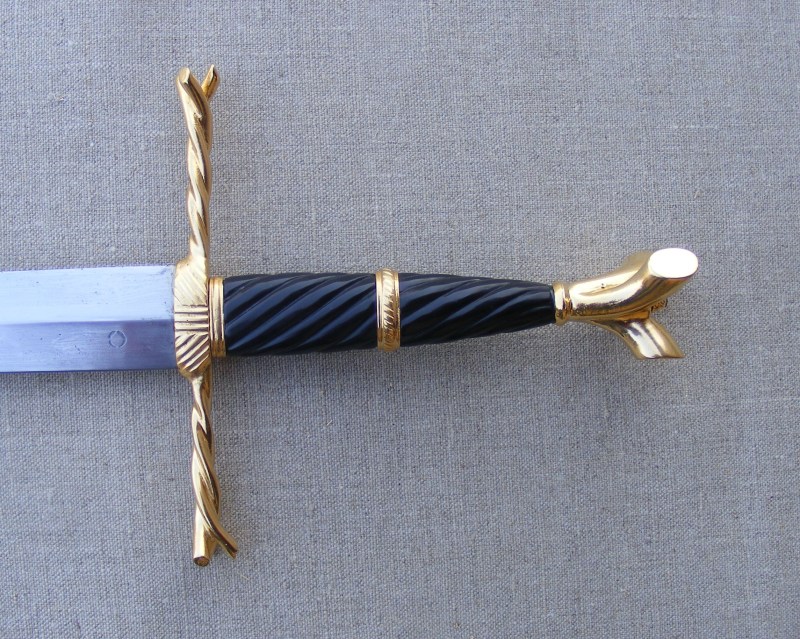
 Attachment: 189.45 KB Attachment: 189.45 KB
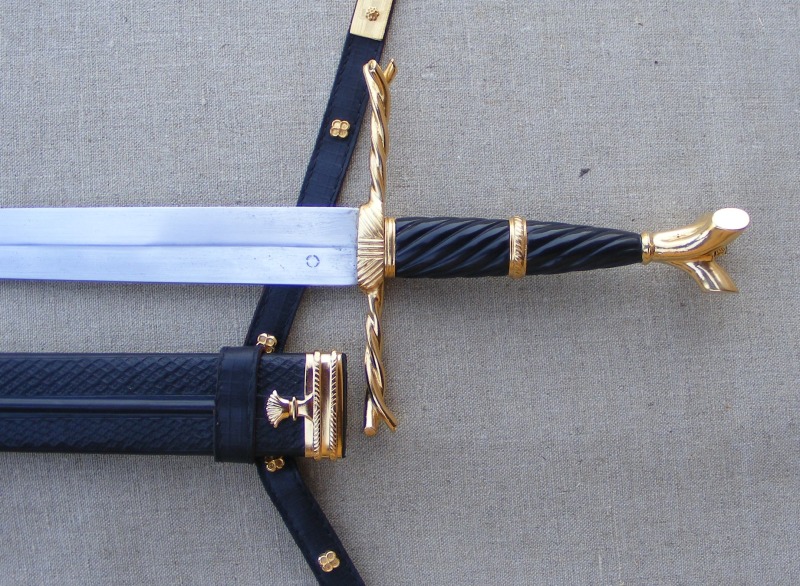
 Attachment: 205.99 KB Attachment: 205.99 KB
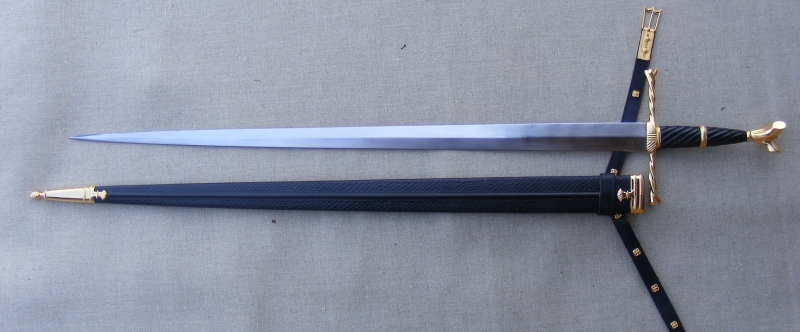
 Attachment: 191.55 KB Attachment: 191.55 KB

 Attachment: 199.79 KB Attachment: 199.79 KB
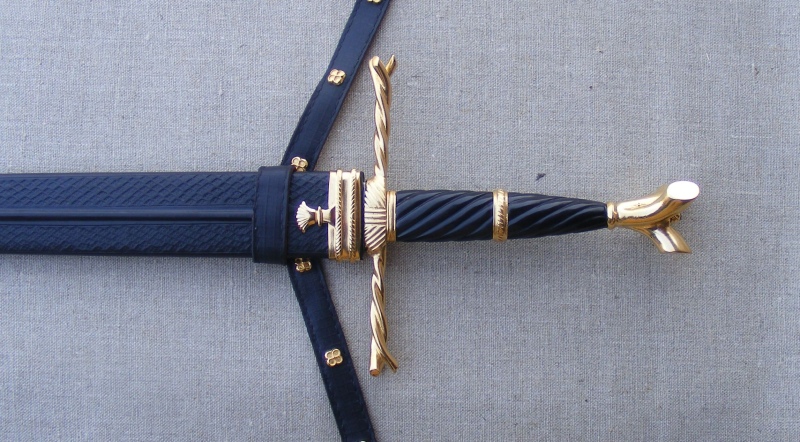
 Attachment: 211.42 KB Attachment: 211.42 KB
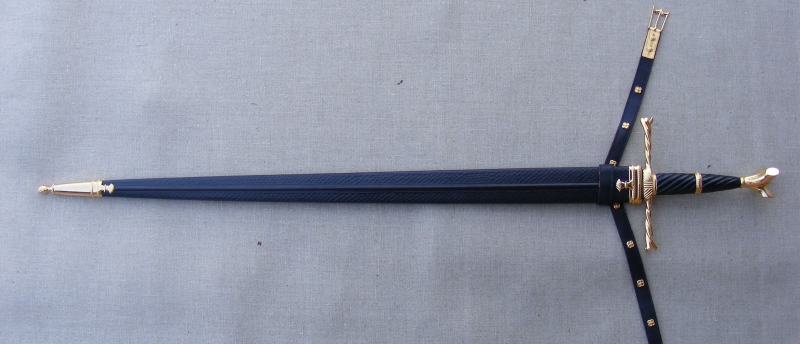
www.todsworkshop.com
www.todcutler.com
www.instagram.com/todsworkshop
https://www.facebook.com/TodsWorkshop
www.youtube.com/user/todsstuff1
|
|
   |
 |
Julien M

|
 Posted: Thu 01 Mar, 2012 8:52 am Post subject: Posted: Thu 01 Mar, 2012 8:52 am Post subject: |
 |
|
That's a hell of a package Tod, beautifully put together and the result is stricking.
Stamping this tiny fleur de lys across the entire surface/lenght of the scabbard must have been pretty fun 
|
|
  |
 |
|
Peter Lyon
Industry Professional
|
 Posted: Thu 01 Mar, 2012 9:24 am Post subject: Posted: Thu 01 Mar, 2012 9:24 am Post subject: |
 |
|
That is beautiful. I have been fortunate enough to handle the original, and it is surprisingly light and almost delicate-feeling in the hand.
Still hammering away
|
|
  |
 |
|
Justin H. Núñez
|
 Posted: Thu 01 Mar, 2012 11:19 am Post subject: Posted: Thu 01 Mar, 2012 11:19 am Post subject: |
 |
|
WOW!  that is amazing! Rich and classy and functional all in one! that is amazing! Rich and classy and functional all in one!
"Nothing in fencing is really difficult, it just takes work." - Aldo Nadi
|
|
  |
 |
Sean Flynt

|
 Posted: Thu 01 Mar, 2012 12:06 pm Post subject: Posted: Thu 01 Mar, 2012 12:06 pm Post subject: |
 |
|
| Peter Lyon wrote: | | That is beautiful. I have been fortunate enough to handle the original, and it is surprisingly light and almost delicate-feeling in the hand. |
Peter: I went looking for a dimly-remembered video showing this sword in a behind-the-scenes RA tour. I came back to post it and realized this is YOU handling that beauty...lucky dog (well, luck and years of hard work  ) )
Everybody will want to see the whole thing, but the unveiling begins at 1:34 http://www.youtube.com/watch?v=JeidJlYUqwM
I was amazed how small it seems.
This one was/is on loan to the Frazier International History Museum in Louisville. I was fortunate enough to see it there in 2007.
-Sean
Author of the Little Hammer novel
https://www.amazon.com/Little-Hammer-Sean-Flynt/dp/B08XN7HZ82/ref=sr_1_1?dchild=1&keywords=little+hammer+book&qid=1627482034&sr=8-1
|
|
   |
 |
Jean Thibodeau

|
 Posted: Thu 01 Mar, 2012 4:08 pm Post subject: Posted: Thu 01 Mar, 2012 4:08 pm Post subject: |
 |
|
Leo a very regal looking sword and I love the contrast between the gold and the black horn grip.
Also the scabbard and scabbard fittings really complete the whole package very well.
You can easily give up your freedom. You have to fight hard to get it back!
|
|
  |
 |
Benjamin Rial

|
 Posted: Thu 01 Mar, 2012 7:54 pm Post subject: Posted: Thu 01 Mar, 2012 7:54 pm Post subject: |
 |
|
Simply Exquisite! Further words seem pointless.
"The only thing new in this world is the history we don't know."-Pres. Harry S. Truman
www.forgedintime.com
Vel Arte, Vel Marte
|
|
   |
 |
|
Paul Watson
|
 Posted: Fri 02 Mar, 2012 11:35 am Post subject: Posted: Fri 02 Mar, 2012 11:35 am Post subject: |
 |
|
I watched the video with Peter Lyon handling the swords and was impressed with the good state of the existing sword, and must add that your recreation certainly does it justice, especially considering the complex nature of the original.
I do not love the bright sword for its sharpness, but that which it protects. (Faramir, The Two Towers)
|
|
  |
 |
Leo Todeschini
Industry Professional

|
|
   |
 |
|
Jeremy V. Krause
|
 Posted: Sat 03 Mar, 2012 2:45 pm Post subject: Posted: Sat 03 Mar, 2012 2:45 pm Post subject: |
 |
|
Tod,
Isn't fire gilding toxic as well, using mercury in the process or something? How would you describe the difference in finish between historical gilding and what we see nowadays? What effect do you shoot for when gilding your pieces to achieve a more period look? Does the modern process simply produce a "shinier" finish, or is the hue different as well?
Beautiful sword BTW.
|
|
  |
 |
Leo Todeschini
Industry Professional

|
 Posted: Sun 04 Mar, 2012 2:14 pm Post subject: Posted: Sun 04 Mar, 2012 2:14 pm Post subject: |
 |
|
Historically the work would have been fire gilded and in this process a amalgam paste of mercury and gold or silver would have been made by basically dissolving the precious metal in the mercury. This will then form a paste that can be painted onto a surface. Once this paste is applied to a metal surface it can be heated up to boil off the mercury and thus leave just the precious metal as a layer.
The finished result is that you have a layer that is of varying thickness and texture so that a gilded piece is quite clearly not electroplated. The thickness is quite substantial and maybe up to 0.5mm thick in places (guess).
The process is toxic as you have to boil off the mercury and although I would in honesty like to have a go, I suspect I would use a lot of gold trying to get it right.
In electroplating the gold layer is around 1 micron thick (1 millionth of a yard) and is applied over a layer of nickel as a base coat. This means that any texture on the surface is shown right through the plating. This means that the surface must be perfectly polished or it comes out variable (in a bad way) and that means that the gold plated piece could be a piece of plastic in appearance and does not look like a gilded piece.
Both methods use 24 carat gold and so the colour is right, but the feel is very different. Gilding has this texture and 'body' because of its application method and electroplating requires a perfect polished finish because of its application method.
What I have done on this piece is a halfway house, so that I have applied a textured plating process that has 'body' and then electroplated over this so that the finished result isvisually much more like traditional gilding, but has the cost effectiveness of a very thin layer of gold as provided by electroplate.
Tod
www.todsworkshop.com
www.todcutler.com
www.instagram.com/todsworkshop
https://www.facebook.com/TodsWorkshop
www.youtube.com/user/todsstuff1
|
|
   |
 |
|
Jeremy V. Krause
|
 Posted: Sun 04 Mar, 2012 6:11 pm Post subject: Posted: Sun 04 Mar, 2012 6:11 pm Post subject: |
 |
|
| Leo Todeschini wrote: | Historically the work would have been fire gilded and in this process a amalgam paste of mercury and gold or silver would have been made by basically dissolving the precious metal in the mercury. This will then form a paste that can be painted onto a surface. Once this paste is applied to a metal surface it can be heated up to boil off the mercury and thus leave just the precious metal as a layer.
The finished result is that you have a layer that is of varying thickness and texture so that a gilded piece is quite clearly not electroplated. The thickness is quite substantial and maybe up to 0.5mm thick in places (guess).
The process is toxic as you have to boil off the mercury and although I would in honesty like to have a go, I suspect I would use a lot of gold trying to get it right.
In electroplating the gold layer is around 1 micron thick (1 millionth of a yard) and is applied over a layer of nickel as a base coat. This means that any texture on the surface is shown right through the plating. This means that the surface must be perfectly polished or it comes out variable (in a bad way) and that means that the gold plated piece could be a piece of plastic in appearance and does not look like a gilded piece.
Both methods use 24 carat gold and so the colour is right, but the feel is very different. Gilding has this texture and 'body' because of its application method and electroplating requires a perfect polished finish because of its application method.
What I have done on this piece is a halfway house, so that I have applied a textured plating process that has 'body' and then electroplated over this so that the finished result isvisually much more like traditional gilding, but has the cost effectiveness of a very thin layer of gold as provided by electroplate.
Tod |
Thanks Tod,
That was interesting and informative. 
|
|
  |
 |
Sean Flynt

|
|
   |
 |
John Giles

|
 Posted: Mon 05 Mar, 2012 12:12 pm Post subject: Peter's museum tour Posted: Mon 05 Mar, 2012 12:12 pm Post subject: Peter's museum tour |
 |
|
Peter, how were you ever able to leave that museum?? It must've killed you to have to leave before handling every sword in the place!!
And Leo, Your reproduction is absolutely beautiful!!!
True Courage is about knowing not when to take a life, but when to spare one.
|
|
  |
 |
Leo Todeschini
Industry Professional

|
 Posted: Tue 06 Mar, 2012 1:15 am Post subject: Posted: Tue 06 Mar, 2012 1:15 am Post subject: |
 |
|
Sean Flynt wrote | Quote: | Tod: Have you ever experimented with this product or similar? http://shop.hobbylobby.com/products/interior-brush-n-leaf-153593/
It's quite thick and could emulate the thickness of fire gilding. It can give the thick, liquid look of fire gilding on small parts (rivet heads, pommel nuts, etc.). I've never tried it on larger hilt surfaces.
I guess this would be the modern equivalent of medieval "shell gold"--gold dust prepared as paint. Surely somebody makes it with real gold for manuscript restorers and other artists.
Alternately, I wonder if it would be possible to use a thick glue over the surfaces of the hilt and then apply 24k leaf when it's still tacky. |
From a purely personal choice I try to steer toward the older ways of doing things when I can and this sort of paint feels wrong to me. I suspect it may not be that durable either but that is really just speculation - sounds like you have had sucess with it though and I trust your judgement.
Gold leaf is possible and actually rather easy to apply, in fact it is almost impossible to mess up, but it is a really delicate finish and is generally for items that are not handled that much with the exception of organics that it just sinks into the surface enough that it keys very well.
Thank you John.
Tod
www.todsworkshop.com
www.todcutler.com
www.instagram.com/todsworkshop
https://www.facebook.com/TodsWorkshop
www.youtube.com/user/todsstuff1
|
|
   |
 |
Sean Flynt

|
|
   |
 |
Jean Thibodeau

|
 Posted: Tue 06 Mar, 2012 10:33 am Post subject: Posted: Tue 06 Mar, 2012 10:33 am Post subject: |
 |
|
| Sean Flynt wrote: | | Yes, the Gold N Leaf certainly wouldn't be for a premium project, and I suppose if shell gold were considered a viable option historically, nobody would have gone to the trouble of fire gilding. I have often wondered what was used on sword chappes, which art suggests included appliques or tacks, paint and some form of gilding. |
I think that your focus is on simulating appearance with some of your projects and that this works real well as you do impressive re-works of uninspiring factory swords ( Or other weapons ) and turn them into very attractive pieces.
in certain context and objectives your solution to replicate the appearance of fire gilding is very useful.
But Leo is trying for getting as close as possible to period pieces even if he has to make some compromises due to cost of some materials or techniques that can't be used for safety reasons like mercury poisoning.
Fire gilding is probably superior to modern and safer methods as the layer of gold being much thicker would be more durable and not wear off as easily ?
You can easily give up your freedom. You have to fight hard to get it back!
|
|
  |
 |
Sean Flynt

|
 Posted: Tue 06 Mar, 2012 11:28 am Post subject: Posted: Tue 06 Mar, 2012 11:28 am Post subject: |
 |
|
| Jean Thibodeau wrote: | | Sean Flynt wrote: | | Yes, the Gold N Leaf certainly wouldn't be for a premium project, and I suppose if shell gold were considered a viable option historically, nobody would have gone to the trouble of fire gilding. I have often wondered what was used on sword chappes, which art suggests included appliques or tacks, paint and some form of gilding. |
I think that your focus is on simulating appearance with some of your projects and that this works real well as you do impressive re-works of uninspiring factory swords ( Or other weapons ) and turn them into very attractive pieces.
in certain context and objectives your solution to replicate the appearance of fire gilding is very useful.
But Leo is trying for getting as close as possible to period pieces even if he has to make some compromises due to cost of some materials or techniques that can't be used for safety reasons like mercury poisoning.
Fire gilding is probably superior to modern and safer methods as the layer of gold being much thicker would be more durable and not wear off as easily ? |
True, all, but once we rule out fire gilding we're getting away from historical practice. And I would guess that genuine gold in suspension (shell gold) and leaf are more historically plausible than gold-over-nickel plating, if obviously more fragile. I'm not suggesting that hilts were painted with shell gold, but with fire gilding ruled out, shell gold might give the look of fire gilding in areas not subject to abrasion. IIRC, Gold N Leaf does not contain real gold.
Here's the real deal, at $138 for 1.05 g. 
http://www.naturalpigments.com/detail.asp?PRODUCT_ID=301-SH2375
I'd hate to think what fire gilding would cost, just in terms of the gold, much less the hazardous waste, specialty skills, etc.
And here's fire gilding in action: http://www.buddhafiguren.de/Movies/Buddha-sta...lding.html
I hope I'm not seeing what I think I'm seeing--is this guy bare-handing the amalgam and breathing the vapors???
-Sean
Author of the Little Hammer novel
https://www.amazon.com/Little-Hammer-Sean-Flynt/dp/B08XN7HZ82/ref=sr_1_1?dchild=1&keywords=little+hammer+book&qid=1627482034&sr=8-1
|
|
   |
 |
Sean Flynt

|
|
   |
 |
|
Matthew Stagmer
Industry Professional
|
 Posted: Tue 06 Mar, 2012 2:06 pm Post subject: Posted: Tue 06 Mar, 2012 2:06 pm Post subject: |
 |
|
Well done my friend! My brother was at Leeds this past summer and held the original in his hands. Loving what you did with the scabbard.
Matthew Stagmer
Maker of custom and production weaponry
Youtube.com/ThatWorks
|
|
   |
 |
|
|

